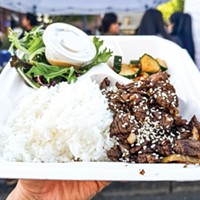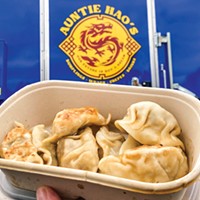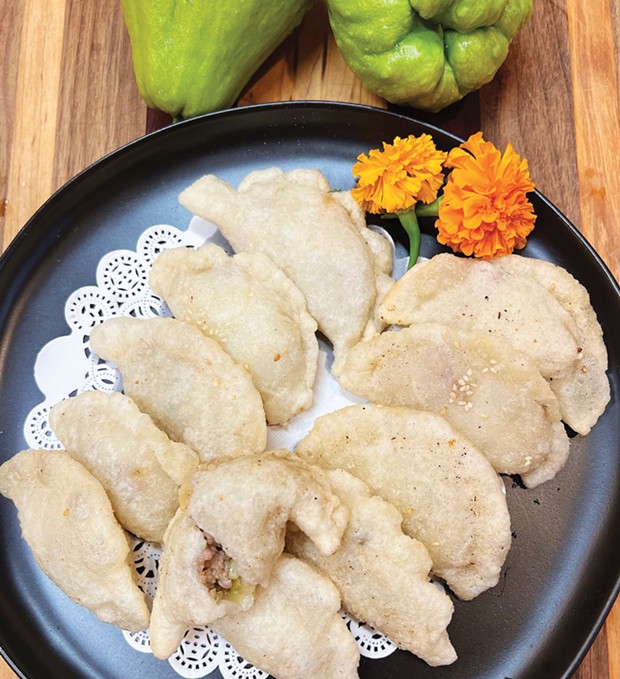[
{
"name": "Top Stories Video Pair",
"insertPoint": "7",
"component": "17087298",
"parentWrapperClass": "fdn-ads-inline-content-block",
"requiredCountToDisplay": "1"
}
]
Chayote, or Buddha's fists squash as we call it in Chinese, is a thin-skinned squash. Some are smooth and others are prickly. I'm ecstatic to share some of my harvest this year and have given over a dozen of the sprouted squash for friends to plant next year. Chayote is a prolific producer in Humboldt. A sunny spot, a large space for them to reach out and you are set. It is a food security blanket for me for the winter. For the last 10 years, my husband has trimmed the plant to minimal size since l wasn't a big fan. This year, he built a large overhead bamboo trellis and let it grow wild. We love sitting under the chayote shed during warm summer days, watching them flowering, counting how many of these cute, tiny fists are sprouting. A couple vines even reached our pear tree, hinting at chayote's other name: vegetable pears.
I remember my parents often stir-fried chayote with dried shrimp, made them into soup with pork bones and braised them with rice. I have recently learned different cultures have their own favorite ways to use them: in salad, stuffed, stewed, deep fried. l'm excited to try them all. One of my favorites is making them into a New Year treat from my childhood, hom gai lone. This fried dumpling, in what's known as the "chicken coop" shape, is particular to my hometown in Guangdong, China. They're always paired with fried sesame seed balls during this holiday, like Yin and Yang. We would bring them to visit family and relatives during Chinese New Year for a lucky year to come.
The original recipe is made with kohlrabi but l substitute with chayote since the texture is similar. With the first bite, you notice the crispy texture and sweet taste of the wrapper. Then the chewiness, salty flavor, crunchy chayote and juicy meat hits — a full array of happiness. I served them for our Thanksgiving as an appetizer since my family and friends were coming from the city, and they enjoy talking about childhood treats and sharing stories with our kids. You can find all the ingredients in local Asian markets. The locally grown prickly chayotes are available during late fall in Oriental Food & Spice on 306 W. Harris St. in Eureka. Better yet, grow your own and share with others!
Hom Gai Lone
Fried rice flour dumplings
You'll need a glass jar with 4-inch flat bottom to form the wrappers. For the glutinous rice flour, I recommend the Thai brand Erawan in the package with the green lettering and the same brand's regular rice flour in the red package. Glutinous rice flour alone makes a soft and gooey dough, whereas the regular rice flour creates a stiff and dry dough. Do not alter the ratio or the dumplings will break open during frying. I also prefer lard for the dough. This can be a gluten-free dish if you substitute gluten-free tamari and oyster sauce. Makes 16-18 dumplings.
Ingredients
For the filling:
1 cup chayote, diced
½ cup ground pork (not extra lean)
1 lap cheong Chinese sausage, diced
¼ cup dried shrimp
2 tablespoons preserved turnip, minced (optional)
1 teaspoon vegetable oil
2 teaspoons soy sauce or coco aminos
1 tablespoon oyster sauce
White pepper to taste
If not using turnip, add ½ teaspoon salt
2 teaspoons cornstarch
3 tablespoons water for slurry
For the dough:
1 ¾ cup (200 grams) glutinous rice flour, plus 2 tablespoons set aside
½ cup (50 grams) regular rice flour
1/3 cup sugar
1 cup water
1 tablespoon sesame seeds
1 tablespoon lard or vegetable oil
7 cups vegetable oil for frying
Prepare the filling first. Soak the dried shrimp in warm water for 15 minutes and drain. Heat a large pan and add 1 teaspoon of vegetable oil. Once the oil is sizzling, add the shrimp and fry until fragrant. Add the ground pork and Chinese sausage, and sauté for few minutes until the pork is no longer pink. Add chayote and preserved turnip, if using. Toss for few minutes before adding the rest of the seasoning. Mix the cornstarch and 3 tablespoons of water to make a slurry and add it to the pan. Cook, stirring, until all ingredients are combined, about 2 minutes. Remove the filling from heat and put it on a plate to cool.
Next, make the dough. Combine sugar and water in a small pot, and boil until sugar dissolves. In a medium bowl, mix both rice flours before pouring in the sugar water and stirring with chopsticks until it's cool. Once it's cool enough to touch, add lard or oil, using your hand to knead the dough until it's fully incorporated into a soft dough. Cover with a towel to avoid drying out and let it sit for 5 minutes.
Divide the dough into 16 to 18 pieces and cover again with the towel. Take one piece out and shape into a ball. Sprinkle some of the reserved rice flour and sesame seeds on a flat surface, and flour the bottom of the 4-inch glass jar to avoid sticking. Press the ball with the jar until flat, to a 3 ½-inch rounded wrapper. If the center is too thick, press and stretch until the whole surface is even. The dough will be starchy and easy to work with. Place the wrapper on your palm and scoop a little more than 1 teaspoon of the filling in the center. Fold the wrapper in half, pinching the edges to seal the half circle. Repeat with each piece until all the dough is finished.
Put the 7 cups of oil in a large, heavy-bottomed pot and heat over a medium burner to until a deep-fry thermometer reads 350 F. Add a few dumplings at a time, careful not to overcrowd the pot. Fry for 10 to 12 minutes, flipping the dumplings once or twice. Once they float to the surface, they are done. The hom gai lone will still be pale, creamy in color or even white. Remove each one to a wire rack to drain, then to a plate lined with paper towels to absorb excess oil. Enjoy them as an appetizer or snack for any gathering. They reheat well in an air fryer or toaster oven.
You can find Home Cooking with Wendy Chan (she/her) classes benefitting local charities on Facebook.
Speaking of...
-

What's Good at the Friday Night Market
Jun 6, 2024 -

Dumplings and Tea at the Carwash
Mar 31, 2023 -

What's Good
Mar 30, 2023 - More »
































